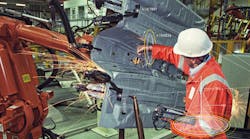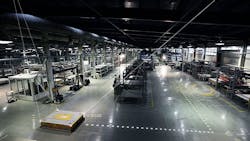Microlocation Creates Robot "Safe Space" with RF Sensors, Not Fences
The way we deal with industrial robots is a bit silly when you think about it. We limit their strength and speed with force-torque sensors and preset protocols so they can work around humans, or stick them behind fences so they can move like the powerful machines they are.
Of course, keeping workers safe is not silly, which these measures are in place for, but not finding a way to optimally leverage machines at the same time is. Instead of slowing down robots so that when they do make contact with humans and no damage will be done, why not improve the machines’ awareness of where their human counterpart is?
“Imagine a robot collaborating with a person using exquisitely precise knowledge of what the person is doing,” teases David Mindell, a professor of Aeronautics and Astronautics at the Massachusetts Institute of Technology, who has spun out a company called Humatics (a portmanteau of humans and robotics) to solve this problem quite exquisitely. In the 1990s, he helped develop a spread-spectrum sonar to detect the infamous sunken WWI ship, the RMS Lusitania.
Using a radio frequency (RF) innovation called microlocation, robots, along with autonomous mobile robots (AMRs) and drones, can sense where other objects are down to the centimeter and even millimeter level, granted they are fitted with a low-power smart tracker. The step-change in precision is expected to enhance how robots “locate, navigate and collaborate,” effectively bridging gaps in spatial awareness between work cells, cobots and human workers. If the robot in a pick-and-place application always know where its fleshy coworker is, it could move faster without fear of accidental contact.
“This enables a greater awareness and collision avoidance,” Mindell says. “With the Humatics Spatial Intelligence Platform, we hope to ramp that up to more common usage.”
If successful, Humatics’ solution offers immediate and significant productivity gains over GPS, which can’t be used reliably indoors and gets within 6 to 10 meters. Machine visioning can be used indoors and does offer breakthrough awareness, costs more and that video data does longer to process. And everyone knows how restrictive the magnetic tape boundaries for AGVs are.
“Microlocation provides improvements in flexibility, makes it much easier to rearrange production lines, reduce infrastructure, and converts big heavy fences into software,” Mindell explains. “Precision always equals performance, whether that means an increase safety or throughput.”
The company’s course towards fulfilling these promises appears to be on an equally precise trajectory. The company’s lead investor is Bill Ford, and a recent acquisition of 5D Robotics allowed Humatics to absorb Time Domain, a company that has already commercialized centimeter-range microlocation with a range of hundreds of meters.
“There’s only two ways to do this precise radio ranging,” Mindell says. “We’re doing it one way; Time Domain was doing it the other. Now we own both of them.”
Mindell talks like a card player with pocket Aces, and he does, so his confident excitement is to be expected. The lightweight, low power aspects should excite any engineer having trouble reconciling how heavy and energy-expensive some machine visioning systems can be. Meanwhile, the throughput improvements should entice production managers.
But there’s a big difference between amazing theoretical tech and practical deployment in factories.
The technology is new and still being beta tested, but Mindell, who also chairs the MIT Task Force on the Work of the Future and is the Dibner Professor of the History of Engineering and Manufacturing, can rattle off dozens of real-life applications in the factory and later, smart cities, which he says the company is “pursuing aggressively.”
An active pilot project with an undisclosed manufacturer is currently proving the Spatial Intelligence Platform is more than just hype. In it, a mobile cart carries parts to a production line, where a robot picks them off.
“In order for them to merge, the cart needs to approach a work cell and must be registered into the shared coordinate frame there,” Mindell says. The microlocation trackers act as tags which the platform converts to answer the most pressing questions the robots have at the moment: “Where am I? Where am I going? How do I relate to surroundings?”
“With mobile platforms going up against fixed assets, you need precision navigation to do that,” Mindell says. “The more precise you are, the faster you can go.”
And right now it looks to be the fastest choice.
“Machine visioning systems may spend 6 to 9 seconds on alignment,” says Mindell, also Humatics’ CEO. “Our system does that instantaneously.”
Saving a few seconds here or there adds up to more parts being delivered, less battery use of the vehicles per trip, and frees up a bevy of other processes that might be waiting for machines to meet up.
The Time Domain IP also gives Humatics access to the ultra-wideband, so these machines’ chatter won’t interfere with, or get scrambled, by the dozens of other communications and IT devices riding RF channels.
Right now the trackers are about as big as a credit card or hockey puck, Mindell says, but “they are rapidly shrinking in size.”
The size reduction will take the tech to much greater heights, as it will bring microlocation to delivery drones, which are now limited by power consumption and weight.
“We see ourselves opening up the whole 3-dimensional space for the factory and the city,” Mindell says. “There’s a lot of underutilized space and this adds a high degree of robustness for drones.”
The centimeter range sensors, PulsON OEM modules, are available now and the millimeter-range sensors should be available in 2019.












